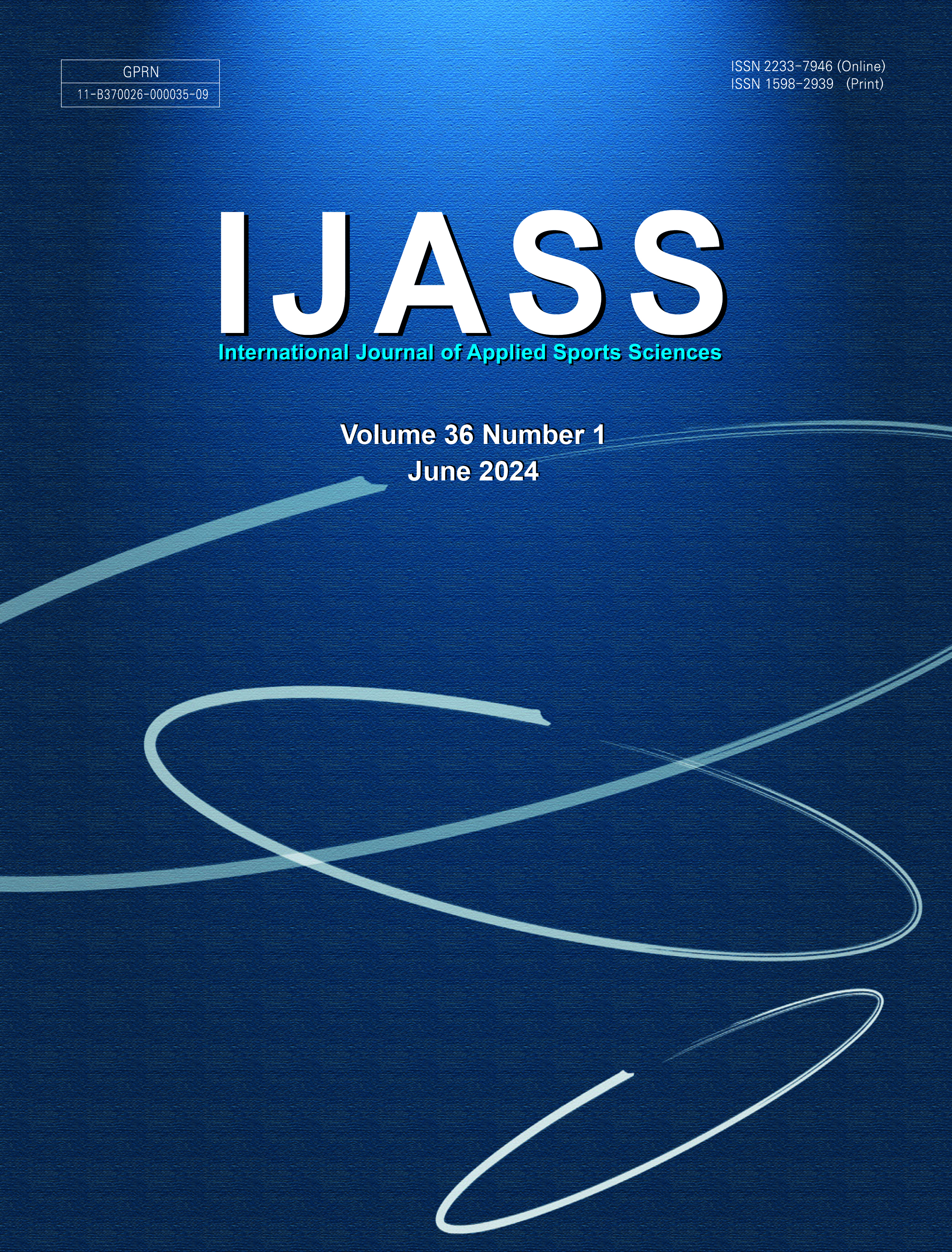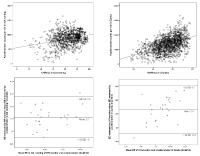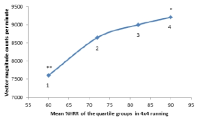 ISSN : 1598-2939
ISSN : 1598-2939

The ability to change directions, cut, and move quickly is paramount to success in basketball. Lateral shuffling movements or side-steps are common in basketball, but few tests incorporate these movements in measures of change-of-direction speed. Furthermore, no reliability or validity information has supported the most popular test, the Edgren Side-Step Test, and the procedures for the Edgren Test have been inconsistent. This study examined 4 lateral shuffle tests (LST), which combined different distances (8 feet and 12 feet) and durations (6 seconds and 10 seconds). All 4 conditions of the LST had very good internal consistency as the Cronbach’s α for each was above 0.889. All 4 conditions had very good test-retest reliability as the ICC (3,1) for each was above 0.930. None of the 4 conditions was found to have a significant relationship with a 20m sprint, whereas the 8x10-LST, r=-0.640, p = 0.046 and the 8x6-LST, r =-0.648, p = 0.043 had a moderate negative relationship with the Hexagon Agility Test. No condition was found to be a discriminator between recreational and competitive basketball players. Based on the results, the LST-8x6 and LST-8x10 appear to be valid and reliable tests for measuring change -of-direction speed.

The purpose of this study is to examine details of domestic and foreign papers that verified the effect of endurance training using molecular biological approaches and to investigate the directivity of molecular biological study, analytical technology and analytical factors for the analysis of training effects. Existing domestic and foreign papers on endurance training that investigated the effect of training based on molecular biological analysis of human beings were reviewed. In order to increase reliability of the selected papers and their compatibility with the purpose of this study, the papers were reclassified by a group of experts that consisted of physical education professors and doctors of exercise physiology. The final papers selected were studied for the change in hormones and enzymes through blood and muscular tissues based on study topic and trend analysis from a macroscopic perspective. Analytical methods used include western blot, RT-PCR, ELISA and immunohistochemistry of molecular biology. Analytical variables investigated / analyzed were ACE, ACTN, PPARs, UCP, mitochondrial DNA variant, creatine kinase, renin-angiotensin, AMPK for blood and COX, myosin binding protein C fast-type, glycogen phosphorylase, pyruvate kinase, GLUT, PPARs, and AMPK for muscle. Such molecular biological analytical techniques and variables should be widely used to provide 1) conditioning of professional athletes and life sports athletes, 2) analysis of training effect, and 3) scientific and future-oriented methods for health enhancement.

Most studies comparing objective measurements of physical activity are carried out on a treadmill or in free living activities and generally at low/moderate intensities. Purpose: To compare energy expenditure, correlation and exercise intensity measured by accelerometer and heart rate (HR) monitor during different exercises. Methods: This is a comparison study testing convergent validity between accelerometer and HR-monitor. A total of 26 participants (15 women) with a mean age of 21.8±2.4 years were included. The ActiGraph GT3X with 60 s epoch length was used to measure the participants’ accelerometer counts. HR was measured using Polar team 2 HR belts during 4x4 min running (four intervals lasting four minutes), 4x4 min spinning and Zumba. Results: Pearson correlation coefficient between mean % HR max and accelerometer counts was 0.69 in Zumba, 0.14 in 4x4 spinning and -0.42 in 4x4 running. Estimated energy expenditure from accelerometer was 2.25±1.69 kcal/min lower, i.e. 18.6 %, than energy expenditure estimated from HR monitor during 4x4 running. The corresponding numbers for 4x4 spinning and Zumba were 6.27±2.18 kcal/min lower, i.e. 55.7% and 2.64±1.78 kcal/min lower, i.e. 23.6%, respectively. A Bland-Altman plot shows that this difference increases with higher activity level in Zumba. For 4x4 min running the HR-monitor and accelerometer classified 76% and 60%, respectively, of the participants’ activity as vigorous intensity. Conclusion: A large instrumental variation in energy estimation across activities was found. Energy expenditure estimated by accelerometer was around 20% lower for 4x4 running and Zumba, and around 50% lower for 4x4 spinning, compared to energy expenditure estimated from HR monitor. The large variation in the correlation coefficients reflects the methodical differences explained in the paper.


The purpose of this study is to review how Korea Institute of Sport Science (KISS) had carried out sports talent identification and selection for enhancing athletic performance over the last three decades. In the 1980s, KISS had to prepare for the 1986 Asian Games and the 1988 Olympic Games. So, KISS developed test items for sports talent identification for various sports and had identified 4,359 sports talents over 30 sport events. Moreover, KISS developed the standards for elite athlete and had selected talented athletes using them. In the 1990s after the two big sports events, KISS established Talented Athlete Selection Center and constructed the foundation of elite athlete recruitment system. In the 2000s, Korea had suffered a lot of difficulties in recruiting new athletes because of government’s birth control policy effect and economic affluence. So, KISS developed an innovative sports talent identification program and had searched about 500 talented children every year. And KISS developed a new talented athlete selection program and had selected 1,682 talented athletes during 2000s. These new sports talent identification and selection programs are flourishing until now and would be the best sources of national team members in the future.
Culture has been studied as a factor that may account for physical activity disparities among different ethnicities in the U.S. Accordingly, acculturation has been one of the most prominent topics studied to explain mechanisms by which an individual or group may adopt a healthy or unhealthy lifestyle. Nevertheless, many studies lack the use of comprehensive theoretical frameworks, hence they are less informative for intervention design and implementation. This study was purposed to: 1) review important concepts of acculturation, and empirical findings regarding its association with physical activity participation, and 2) propose plausible syntheses of psychosocial theories of physical activity behavior and acculturative variables. The pros and cons of unidirectional and bidirectional models of acculturation were compared in terms of their theoretical plausibility as well as practicality. Acculturation has generally been found to be positively associated with leisure-time physical activity. Nevertheless, its impact on non leisure-time physical activity is still inconclusive. Lastly, we proposed that acculturation may affect physical activity participation through intrapersonal, interpersonal, and sociocultural streams of influence, adopting the typology of Flay et al.’s (2009) theory of triadic influence.
The purpose of this study was to investigate the specific computer programs used by sport organization personnel, the tasks they completed with those programs, and the expectations personnel possessed with regard to computer competencies they would expect from job applicants who hold a degree in sport management. Thirty-five practitioners employed at various sport organizations participated in semi-structured interviews. Participants utilized programs within Microsoft Office (e.g., Word, Excel) and Adobe Creative Suite (e.g., InDesign, Photoshop) to complete essential job tasks. Various specialty programs were also utilized. Job candidates were expected to possess familiarity and competence with programs used by the participants.